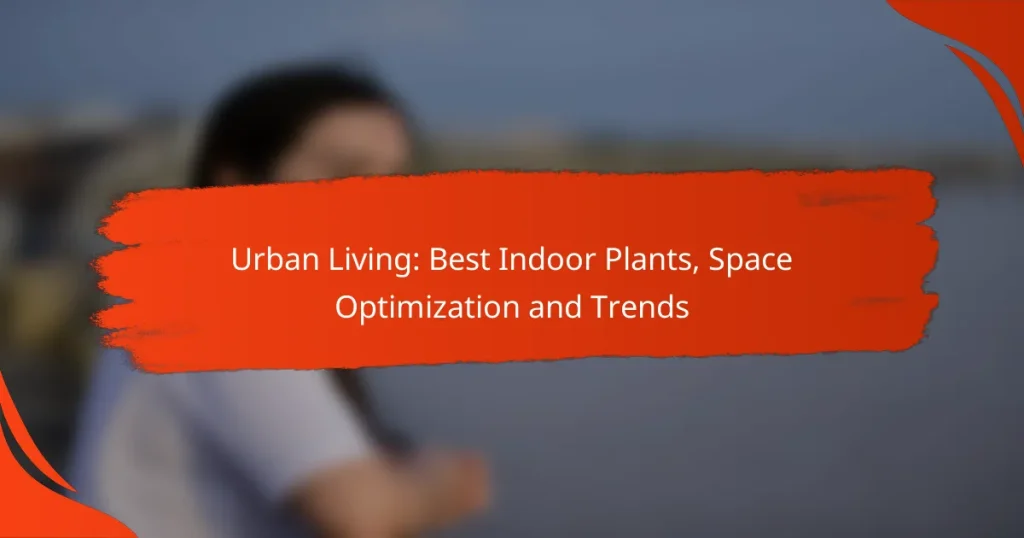As we embrace 2024, indoor plant trends are shifting towards biophilic design, highlighting the importance of integrating nature into our living spaces. These trends not only focus on aesthetic appeal but also emphasize the practical benefits of low-maintenance varieties that improve air quality and enhance overall well-being. By choosing the right plants, even small spaces can become vibrant, harmonious environments that promote comfort and productivity.
Urban Living: Best Indoor Plants, Space Optimization and Trends
What are the top indoor plant trends for 2024?
The top indoor plant trends for 2024 focus on enhancing living spaces through biophilic design, low-maintenance varieties, and vibrant foliage. These trends emphasize creating a harmonious environment that promotes well-being while being practical for everyday living.
Biophilic design integration
Biophilic design integration involves incorporating natural elements into indoor spaces to foster a connection with nature. This trend encourages the use of plants to improve air quality and create a calming atmosphere. Consider placing plants in areas where natural light is abundant, such as near windows or in sunrooms.
To effectively integrate biophilic design, choose plants that thrive indoors, such as snake plants or pothos. These plants not only enhance aesthetics but also contribute to a healthier living environment.
Low-maintenance plant varieties
Low-maintenance plant varieties are ideal for busy lifestyles, requiring minimal care while still providing beauty. Popular choices include succulents, ZZ plants, and peace lilies, which can thrive in various lighting conditions and need infrequent watering.
When selecting low-maintenance plants, consider their growth habits and space requirements. Grouping plants with similar care needs can simplify maintenance and create a cohesive look.
Statement plants for focal points
Statement plants serve as focal points in a room, drawing attention and adding character. Large plants like fiddle leaf figs or monstera can create dramatic visual interest and become conversation starters.
When incorporating statement plants, ensure they are placed in areas where they can be appreciated, such as entryways or living rooms. Consider the scale of the plant in relation to the space to maintain balance.
Colorful foliage selections
Colorful foliage selections add vibrancy and personality to indoor spaces. Plants like calatheas and crotons offer striking leaf patterns and hues, making them perfect for enhancing decor.
To maximize the impact of colorful foliage, mix and match plants with different colors and textures. This variety can create a dynamic display that enlivens any room.
Eco-friendly plant care products
Eco-friendly plant care products are gaining popularity as more people seek sustainable options for maintaining their indoor gardens. Organic fertilizers and biodegradable pots are examples of products that support plant health while being environmentally conscious.
When choosing plant care products, look for certifications or labels indicating sustainability. This approach not only benefits your plants but also contributes to a healthier planet.
How can indoor plants improve living spaces?
Indoor plants can significantly enhance living spaces by improving air quality, increasing humidity levels, and boosting mood and productivity. These benefits contribute to a healthier and more pleasant environment, making homes more enjoyable and comfortable.
Enhanced air quality
Indoor plants improve air quality by absorbing carbon dioxide and releasing oxygen through photosynthesis. They can also filter out common indoor pollutants such as formaldehyde, benzene, and trichloroethylene, which are often found in household products and furnishings.
To maximize air purification, consider incorporating a variety of plants known for their filtering abilities, such as spider plants, peace lilies, and snake plants. Aim for at least one plant per 100 square feet of living space for optimal benefits.
Increased humidity levels
Plants naturally release moisture into the air through a process called transpiration, which can help increase humidity levels in dry indoor environments. This is particularly beneficial during winter months when heating systems can lower humidity.
To effectively boost humidity, group plants together or place them in areas with limited airflow. Consider using a humidifier in conjunction with your plants to maintain a comfortable humidity level, ideally between 30% and 50%.
Boosted mood and productivity
Having indoor plants can enhance mood and productivity by providing a calming effect and reducing stress. Studies suggest that being around greenery can improve focus and creativity, making it easier to work or relax.
To harness these benefits, place plants in workspaces or areas where you spend significant time. Low-maintenance options like pothos or ZZ plants are ideal for busy individuals, as they require minimal care while still providing aesthetic and psychological benefits.
Which indoor plants are best for small spaces?
For small spaces, the best indoor plants are those that require minimal care and can thrive in limited light and space. Compact plants like the snake plant, pothos, and ZZ plant are ideal choices due to their adaptability and low maintenance needs.
Snake plant
The snake plant, also known as Sansevieria, is perfect for small spaces due to its upright growth and ability to tolerate low light. It requires infrequent watering, making it a low-maintenance option for busy individuals.
This plant can grow in various conditions and is known for its air-purifying qualities, which can enhance indoor air quality. Place it in a corner or on a shelf to maximize space while enjoying its striking appearance.
Pothos
Pothos, or Epipremnum aureum, is a versatile vine that thrives in small spaces and can be trained to grow along shelves or hang from pots. It adapts well to different lighting conditions, from low to bright indirect light.
This plant is forgiving if you forget to water it occasionally, making it suitable for beginners. Its trailing vines can add a touch of greenery to any room without taking up much floor space.
ZZ plant
The ZZ plant, or Zamioculcas zamiifolia, is another excellent choice for small areas due to its compact size and tolerance for neglect. It thrives in low light and requires minimal watering, making it ideal for those who may not have a green thumb.
Its glossy leaves add a modern aesthetic to your living space, and it can be placed on a desk or a small table. Just be cautious, as the plant is mildly toxic if ingested, so keep it out of reach of pets and children.
What are the best indoor plants for low light?
Several indoor plants thrive in low light conditions, making them ideal for spaces with limited natural sunlight. Key options include the cast iron plant, peace lily, and spider plant, all known for their resilience and ability to purify the air.
Cast iron plant
The cast iron plant is renowned for its durability and ability to survive in low light. It requires minimal care, making it perfect for busy individuals or those new to plant care.
When growing a cast iron plant, ensure it is in well-draining soil and water it only when the top inch of soil feels dry. This plant can tolerate neglect, but avoid overwatering to prevent root rot.
Peace lily
The peace lily is another excellent choice for low light environments, offering beautiful white blooms that can brighten up any room. It also has air-purifying qualities, which can improve indoor air quality.
To care for a peace lily, place it in indirect light and keep the soil consistently moist but not soggy. If the leaves start to droop, it’s a sign that it needs water, making it easy to gauge its needs.
Spider plant
The spider plant is a popular indoor choice due to its attractive arching leaves and ease of propagation. It thrives in low light but can also adapt to brighter conditions, making it versatile for various spaces.
For optimal growth, keep the spider plant in well-draining soil and water it when the top layer feels dry. Regularly removing any brown tips will help maintain its appearance and health.
How to choose the right indoor plants for your home?
Choosing the right indoor plants involves considering factors like light conditions, humidity levels, and your personal preferences. Assess your living space to determine which plants will thrive and enhance your environment.
Consider light conditions
Different indoor plants require varying levels of light, from low to bright indirect sunlight. Assess the natural light in your home by observing each room throughout the day. For low-light areas, consider plants like snake plants or pothos, while bright spaces can accommodate succulents or fiddle leaf figs.
Assess humidity levels
Humidity is crucial for many indoor plants, especially tropical varieties. If your home has low humidity, you might need to mist your plants regularly or use a humidifier. Plants such as peace lilies and ferns thrive in higher humidity, making them suitable for bathrooms or kitchens.
Choose plants that fit your lifestyle
Your lifestyle plays a significant role in plant selection. If you travel frequently or have a busy schedule, opt for low-maintenance plants like ZZ plants or cacti that require minimal care. For those who enjoy gardening, consider more demanding species that offer a rewarding challenge.
Match your aesthetic preferences
Indoor plants can significantly enhance your home’s decor. Choose plants that complement your style, whether it’s modern, bohemian, or minimalist. Consider the size, shape, and color of the plants to create a cohesive look that reflects your personality.

